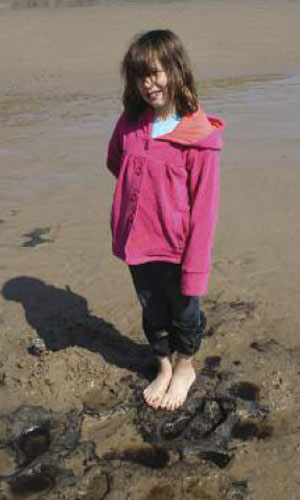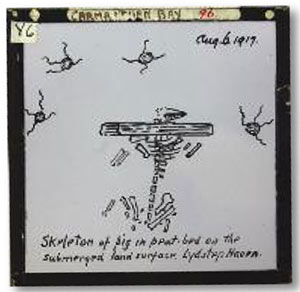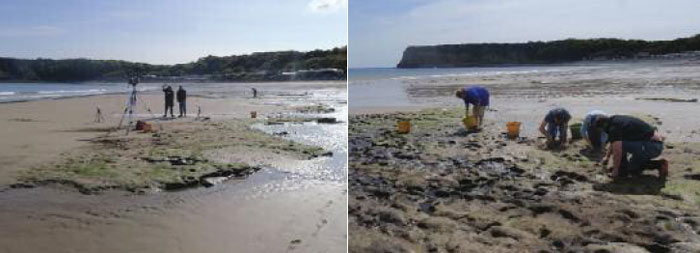
Archaeological excavations in the Severn Estuary by The University of Reading
in 2001
(Photo © Hawlfrainty Goron: CBHC © RCAHMW Crown Copyright)
|

(Photo Dyfed Archaeological Trust)

Original 1917 excavation drawing of the Lydstep pig on a glass slide
(Photo Dyfed ArchaeologicalTrust)
The Lydstep pig – missing meal or ancestral offering? Some of the most extraordinary finds to date from the late Mesolithic have been made at Lydstep, Pembrokeshire, which allow us a rare snapshot of a transitory moment in prehistory. In 1917 a pig skeleton, dated to 6,300 years ago, was found trapped beneath a tree trunk, with two broken flint points in its neck. It appears that it eluded its hunters, only to die later of its wounds in the cover of the forest. Although many finds of animal bone have been retrieved from deposits associated with the submerged forests, it is very rare to find clear signs of hunting. Further exciting discoveries were made at Lydstep in 2010 when a local resident contacted Dyfed Archaeological Trust to report footprints on the beach close to the location of the pig skeleton discovery. The Trust recorded red deer hoof prints preserved in the surface of a solidified peat deposit that once formed the floor of a shallow lagoon in the later Mesolithic. Human footprints were also present, including those of children, their prints deeply embedded into the peat as if they had stood patiently waiting in one place – perhaps as part of a hunting party laying ambush in the reeds around the watering hole? It appears that the hunters might have gone hungry that day, although an alternative interpretation of events is that the pig did not escape but its body was used as a votive offering at the water’s edge, pinned down by a tree trunk. Such ritualistic acts associated with water are known to have been widespread in later periods and it is possible, although difficult to prove, that Mesolithic communities saw the water as the home of their ancestors. |
'This is what we do archaeology for. I can stand exactly where a Mesolithic hunter stood and beside me my eight-year old daughter can stand in footprints where a similar aged child 6,000 years ago squashed her feet into soft muds and silts of a shallow pond. Although separated by six millennia the shared human experience is almost tangible. I’m on a windswept beach in west Wales teaching my daughter about archaeology. Six thousand years ago in exactly the same place a father trained his child in hunting as they stood amongst the reeds and waited for animals to come down to drink'. Ken Murphy, director Dyfed Archaeological Trust |
|

